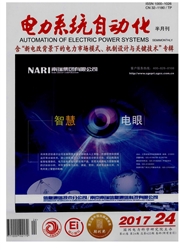

 中文摘要:
中文摘要:
针对带并联电抗器的超高压输电线路,详细分析了发生单相瞬时及永久性故障时,故障相并联补偿电流自由分量的故障特征,并在此基础上提出一种利用并联补偿电流自由分量的变化特征进行故障识别的单相自适应重合闸新判据。永久性故障时,故障点一直存在,并联电抗器通过线路和故障点对地放电,自由分量呈现衰减趋势;瞬时性故障时,二次电弧的熄灭和重燃以及彻底熄弧后自由振荡分量的出现,使得自由分量也随之变化。可见,在不同故障类型下,并联补偿电流自由分量的变化特征有明显差异,因此可用于进行故障识别。大量ATP/EMTP电磁暂态仿真表明,所提出的方法能够快速、准确地识别故障性质,且基本不受线路长短、熄弧时间、故障位置、采样频率等因素的影响,适用于带并联补偿输电线路的快速单相自适应重合闸。
 英文摘要:
英文摘要:
By analyzing the characteristic of decaying component of the fault phase shunt reactor current under different type of faults,a new criterion for single-phase adaptive reclosure is proposed.In this method,fault type can be identified through different variation trends of the decaying component.When permanent fault occurs,the energy of the shunt reactor will be discharged to earth through the fault point,so the decaying component will degrade to zero gradually;When transient fault occurs,the extinction and restrike of the secondary arc and the resonant component,which appears after the secondary arc is completely extinguished,force decaying component to follow the variation.Thus,by detecting the different variation trends of the decaying component,whether the fault is transient or permanent can be recognized.A large number of ATP/EMTP simulation results show that the method can identify the fault type rapidly and precisely.Furthermore,it is immune to the length of transmission lines,extinguished time of secondary arc,fault location and sampling frequency,etc.
 同期刊论文项目
同期刊论文项目
 同项目期刊论文
同项目期刊论文
 A Fault Diagnosis Method of Power Systems Based on Improved Objective Function and Genetic Algorithm
A Fault Diagnosis Method of Power Systems Based on Improved Objective Function and Genetic Algorithm First-Zone Distance Relaying Algorithm of Parallel Transmission Lines for Cross-Country Grounded Fau
First-Zone Distance Relaying Algorithm of Parallel Transmission Lines for Cross-Country Grounded Fau Fault discrimination using synchronized sequence measurements under strong white gaussian noise back
Fault discrimination using synchronized sequence measurements under strong white gaussian noise back First-Zone Distance Relaying Algorithm of Parallel Transmission Lines for Cross-Country Nonearthed F
First-Zone Distance Relaying Algorithm of Parallel Transmission Lines for Cross-Country Nonearthed F Application of Wide-area Collocated Control Technique for Damping Inter-area Oscillations Using Flex
Application of Wide-area Collocated Control Technique for Damping Inter-area Oscillations Using Flex Adaptive Damping Control of Inter-Area Oscillations Based on Federated Kalman Filter Using Wide Area
Adaptive Damping Control of Inter-Area Oscillations Based on Federated Kalman Filter Using Wide Area 期刊信息
期刊信息
